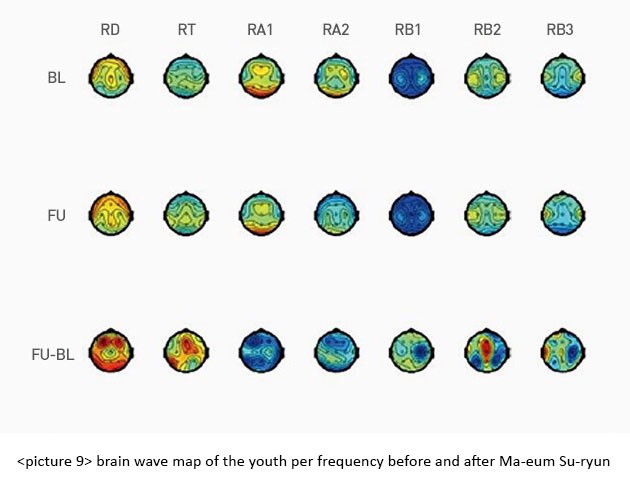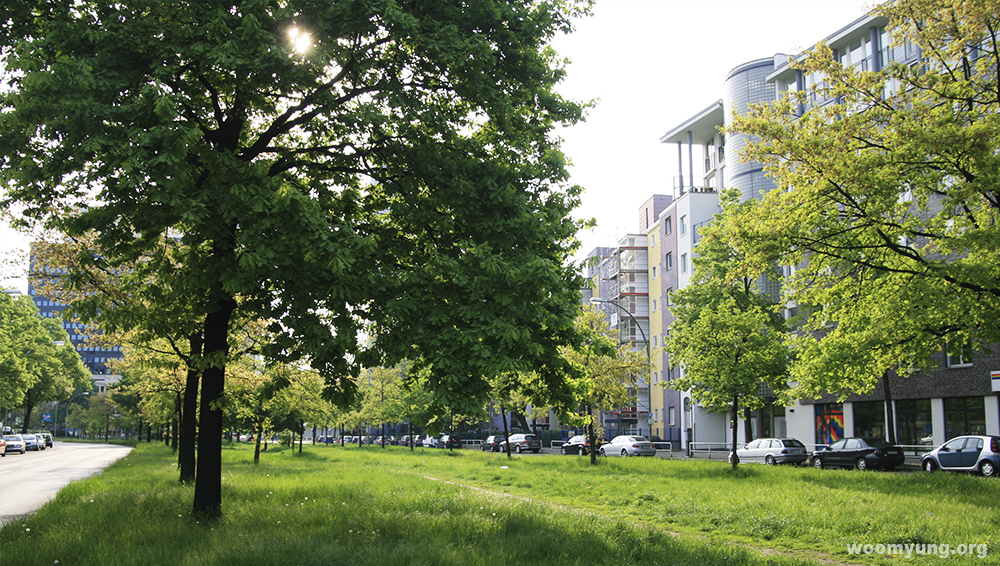Researchers
Lee, D. J. Professor, KAIST
Kim, J. M. Professor, Choongnam University
Jung, G. Y. Professor, Korea University
Yi, E. J. CEO, Junju art healing center
Lee, I S. Professor, Korea Transportation University
Publisher Journal of Human Completion Vol. 4
Published year 2013
Brain wave changes were analyzed after youth participated for 19 days and school teachers for 7 days of the Ma-eum Su-ryun program. The common finding for both youth and teachers was that there was a statistically significant decrease in alpha-2 brain wave. This indicated an increase in focus and concentration. With teachers, there was a change of brain waves originating from occipital lobe, whereas for the youth, there was a significant change in brain waves from the frontal lobe. This was because for the youth, the frontal lobe is still being developed at their age and that is why we think the change was noted. Also there were more days of Ma-eum Su-ryun for the youth than the school teachers in this study. Possibly if the teachers were able to participate more days in the Ma-eum Su-ryun program, they may also exhibit similar changes in the frontal lobe as the youth had exhibited.
Shows before (BL) and after (FU) brain wave map of the youth and change/differences between before and after (FU-BL) Ma-eum Su-ryun. As seen in <picture 9> the level of change in brain waves are different per frequency (RD, RT, RA1, RA2, RB1, RB2, RB3; Delta, Theta, Alpha-1, Alpha-2, Beta-1, Beta-2, and Beta-3).
A statistically significant brain wave change was shown in alpha-2 after participation in the Ma-eum Su-ryun program, which indicates an increase in focus and concentration.
For the youth, there was a significant brain wave change in alpha-2 from overall brain regions, especially the frontal lobe. This frontal lobe is known to be important in cognition, thinking and decision making.
Necessity of the study
Recently, student suicides and school violence are becoming serious enough to be seen as social problems and issues. Unfortunately, these types of critical problems are occurring within our society beyond school organizations or special groups.
Ma-eum Su-ryun explains that memorized lived life of human is a false mind, often stored in the mind as images. The memorized thoughts are stored with emotions and continue to influence mind and behaviors. If these images of false mind are cleansed out, then stored emotions are also thrown out, leading to the recovery of true mind.
There are many research studies being completed on the Ma-eum Su-ryun currently. Schools worldwide are examining innovative strategic approaches in order to satisfy educational, social and emotional demands of students. Various meditation programs are introduced as one of the strategies (Wisner, Jones & Gwin, 2010), with some specific meditation research studies analyzing the changes of brain waves after meditation programs.
But it is still rare to find meditation research studies completed on children or youth at this time; especially rare are brain wave analyses for the population of school teachers and youth participating in meditation programs.
This study aimed to examine changes to brain waves in youth and school teachers after attending Ma-eum Su-ryun program which helps to remove past false minds.
Especially in the case of school teachers and youth, we must consider their influence on one another. In building the important foundation for the youth’s psychosocial and emotional development, it is advisable for both the school teachers as well as the youth to complete the Ma-eum Su-ryun program. We believe positive changes will occur more quickly if both meditated together. Further, using the Ma-eum Su-ryun program as a part of character development education for school students would be exceptionally meaningful.
Study purpose
The purpose of this study was to explore the effect of Ma-eum Su-ryun program by quantifying psychological states through a biological approach. Brain function pre- and post-Ma-eum Su-ryun program would be tested using brain waves as a psychological indicator to examine the beneficial effect of the program.
Study method
1. Study participants
The study participants are 16 youth attendees (out of 357 total who attended) of Ma-eum Su-ryun youth camp (2011. 12. 30 ~ 2012. 1. 18.), whose parents consented their children’s participation in the study, which included completing questionnaires, survey (pictures), physical assessment, and brain wave testing.
The 19-day camp program was located in Namwon city of Jeolla-Bookdo and the attendees finished up to level 3 of the program before being tested. The 16 school teachers attended for 7 days (1/7/12-1/14/12) as a part of teacher training program to finish up to level 1 of the program; and received questionnaires, physical assessment, and brain wave testing to complete.
The brain wave testing occurred at neurology department of Choong-nam university hospital and its analysis occurred at Korea University hospital. The brain waves of 8 (out of 16) youth and 5 of the school teachers were able to be analyzed statistically.
2. Measuring tools and analysis method
19 regional areas of brain wave measurement was completed by Choong-nam University’s Compumedics and were stored in Frofusion EEG4 software. Before and after the camp program, the brain waves were measured with 5 minutes with eyes closed initially; then 5 more minutes with eyes open, then another 5 minutes with eyes closed.
20 samplings of 1 second signals within 1~50Hz frequencies (per 15 minutes) were used to be analyzed at neuroscience department, Korea University.
A total of 256 sample data (per 1 second) were obtained for the analyses. There were a total of 7 bands (delta 1~4Hz; theta 4~8Hz; alpha-1 8~10Hz; alpha-2 10~12Hz; beta-1 12~19Hz; beta -2 19~24Hz; beta-3 24~30Hz)
3. The Ma-eum Su-ryun program
The 19-day youth camp program consists of different levels of meditation (up to level 3) based on mind cleansing principles of the Ma-eum Su-ryun.
Two program instructors are placed with each camping group comprising of 10 students. Meditation sessions occurred 5 times a day (each session is about 1 hour to 1 hour 50 minutes). Movies and other entertainments were provided one day in each week. The school teachers attended the program for 7 days.
Conclusion
In both youth and school teachers, there was statistically significant decreases in alpha-2 brain waves after the program. This indicated increases in their focus and concentration due to the program. The results from mental health and psychological questionnaires also showed significant effects of decreased depression and anxiety, and increase in self-esteem.
It was interesting to note that in the youth group, the changes in alpha-2 occurred in overall brain regions, especially the frontal lobe; whereas, this change was seen in the occipital lobe for the school teachers. We can reason that this frontal lobe change in youth is more noticeable because the frontal lobe is being developed at their age.
Also we need to note that for the youth, their program was much longer (19 days) as opposed to the school teacher’s 7 days of the program. When considering both groups’ changes in occipital lobes after the program, if the school teachers had longer program (similar to the youth), then their frontal lobe may also show change. We think that in future research, it would be meaningful and pertinent to examine school teachers’ frontal lobe changes after at least 19 days of the program.
Other research studies had shown positive brain wave changes in long-term meditators. It is meaningful that in this study, we were able to see changes in their brain waves after only a short duration of the meditation program. These positive changes (i.e. increase in focus and concentration) occurred not just during their meditation sessions as other studies had shown, but also after the program had ended. It is encouraging to see that not yet developed brains (such as in youth who are still in the process of fully developing their brains) can be positively influenced, developed, and healed with this program.
Source: www.meditationlife.org






